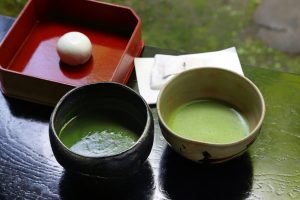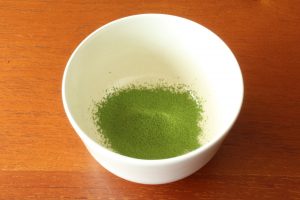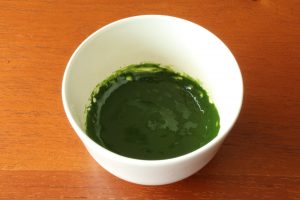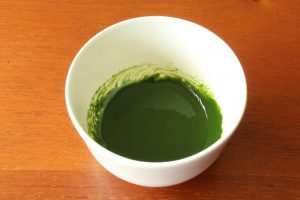
Did you know that there’s another traditional way to prepare matcha?
The matcha that we mostly see pictures of is usucha (薄茶, thin tea).
Usucha has a layer of foam on its surface.
But there’s also koicha (濃茶, thick tea). As its name implies, it is more concentrated.
Koicha has a powerful flavor and aroma. The texture is also much different than what you’ll find in any other tea.
In the Japanese tea ceremony each person drinks his own bowl of usucha, but in the case of koicha it is shared.
In that sense, it has a special significance.
I’m not trained in the tea ceremony, but I’ll tell you what I’ve found regarding how to make koicha.
How to prepare koicha at home
Generally, you’ll find instructions saying that you should add 3 scoops of matcha using the bamboo spoon (chashaku), which would be from 3.5 to 4 grams, and about 30 ml (1 oz) of water.
There are several problems with these general guidelines, though.
It’s very hard to actually get 1 gram in one scoop, it’s always much less no matter how full the chashaku is.
I would say that a full scoop is about 0.75, and of course this depends on the chashaku.
So as you can see, if you go by scoops, 3 scoops would be about 2.25 grams. On the other hand, if you start with grams, you need about 5 scoops to get the 3.75 grams.
You can do it either way and adjust the water volume, but what I can tell you is that it’s definitely less than 30 ml (1 oz) of water in each case.
After many attempts, here’s my suggestion:
5 scoops of matcha, which is about 3.75 grams, and around 20 ml (0.66 oz) of water in total.
How to knead koicha
 Note that this is a casual way of preparing koicha at home.
Note that this is a casual way of preparing koicha at home.
It’s definitely not the proper way to make it at a tea ceremony.
First of all, I highly recommend that you sift the matcha.
If there are lumps in your koicha, it will negatively alter the thickness.
Add the 5 scoops of sifted matcha to the matcha bowl. The scoops themselves should be quite full, otherwise you won’t have enough grams of matcha.
 Out of the approximately 20 ml of water in total, add a little bit to the matcha and knead with the tea whisk.
Out of the approximately 20 ml of water in total, add a little bit to the matcha and knead with the tea whisk.
You should be able to knead slowly without much effort.
Don’t spread the koicha all around the sides of your bowl, keep it at the bottom.
The initial water can be either hot or cold. I prefer hot because koicha tends to cool easily. It also gives off more aroma.
At this point, it’s too thick. If you try to drink it, it will hardly slide down until it reaches your lips.
Hence, add the rest of the water and knead until it is ready.
 You’ll quickly find if you prepared you koicha correctly or not.
You’ll quickly find if you prepared you koicha correctly or not.
Koicha has a luster on its surface and is quite thick.
If yours seems too thin, then you added too much water (the most common mistake I did) or too few grams of matcha.
Also, once you drink it there should be no lumps left. That indicates that it was correctly kneaded.
Use a high quality matcha for koicha
Koicha is so concectrated, that the only way that it’s going to taste good is with a very high quality matcha. Otherwise it will be too bitter.
But my advise when starting out is to practice making it is with a cheaper matcha. Believe me when I tell you that you’ll have many failed attempts.
As with usucha, the only way to get better is to practice.
I’m sure that someone that has been practicing the tea ceremony for years will tell me that I’m doing a lot of mistakes.
I promise that I’ll be making koicha more often from now on, because I do need the practice.

July 30, 2018
Which koicha do you suggest for beginners?
Which koicha do you suggest for an unbelievable koicha experience?
July 30, 2018
Hi Juliette
Thanks for your comment.
The higher the quality of the ceremonial matcha the better. It’s not suitable for culinary grade matcha because it would be too bitter.
July 31, 2018
Thank you for your reply Ricardo. I drink usucha matcha every morning and love it.
Do you have a preferred producer/brand of koicha matcha powder? Which would be your top pick for an amazing koicha?
Can I assume the higher the price, the better the matcha powder? I’m gently exploring slightly more expensive matcha (not the culinary grade). But if I really went for it, what would you recommend?
July 31, 2018
Hi Juliette
It’s hard for me to tell you a preferred brand, I’m always reviewing teas and so it’s not like I always drink the same ones.
Yes, the higher the price it’s usually because the matcha is better. I guess that you can’t go wrong with a ceremonial matcha from Uji or Nishio, both areas are famous for their matcha.
October 9, 2018
I’ve been studying tea ceremony for about 20 years. You definitely want the highest grade matcha for koicha. In fact, Japanese sell many different grades of matcha for both usucha (thin) and koicha (thick). Marukyu-Koyamaen and Ippodo are two very reputable tea manufacturers in Japan with high-quality usucha and koicha. BTW, if you try to use culinary grade matcha to drink, the flavor will be bitter and probably fairly unpleasant. I wouldn’t use a low grade usucha to make koicha (for drinking) either. If you are buying something labeled “ceremonial grade” it is probably best used only for usucha. The Japanese companies will usually indicate if their matcha is culinary, usucha, or koicha grade. However, as you mention, the price should indicate quality.
October 9, 2018
Hi Rhonda
Thanks for your comment. You are right, only the best matchas are suitable for koicha.
November 12, 2019
your ratio of water to tea is pretty much exactly what i have settled on with experimenting. 6 scoops 25 mL. thanks!
November 12, 2019
Have fun with your koicha 🙂